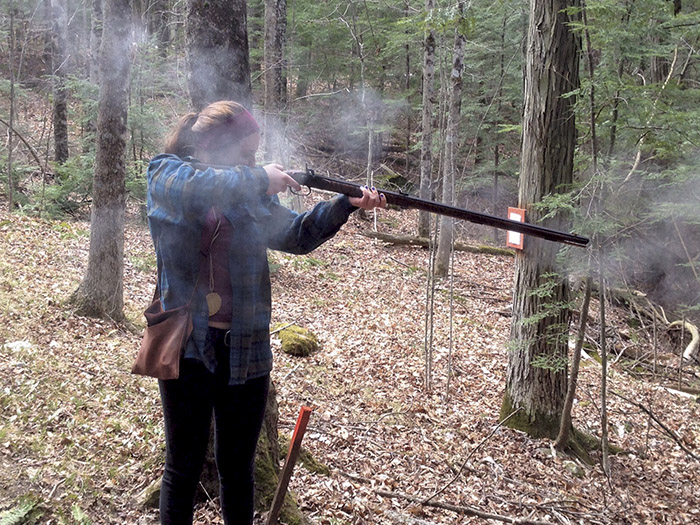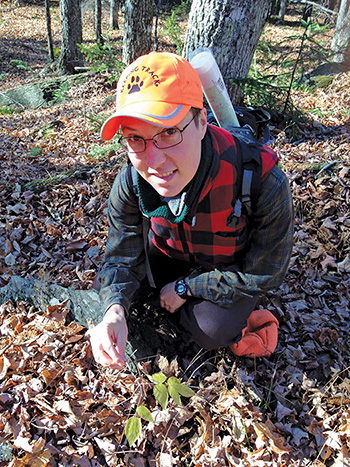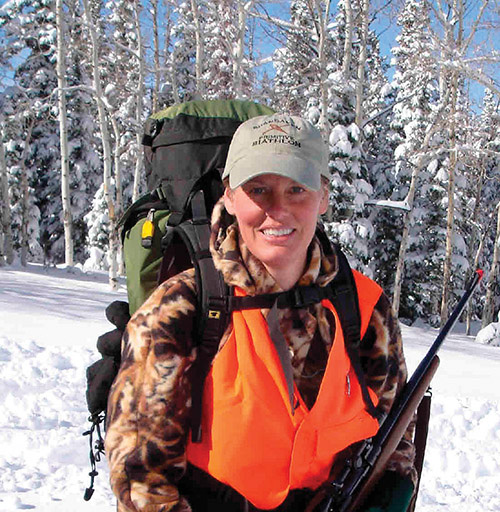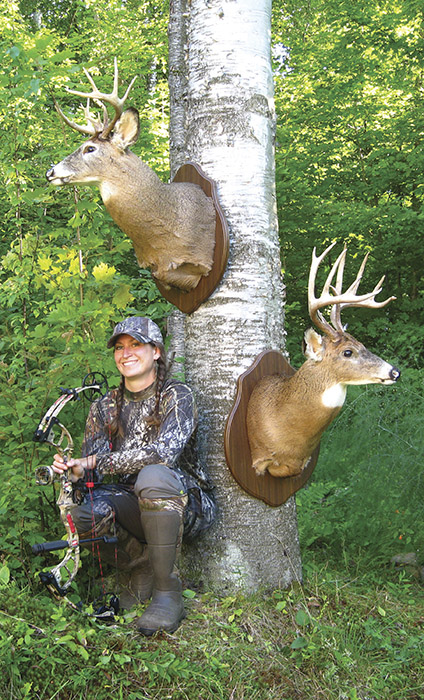| Women: The Spirit and Face of a New Hunting Paradigm | |||||
| by Amy Brooks Thornton | |||||
|
|||||
Wendy Butler hunts with a custom-made flintlock made from bird's-eye maple her grandfather collected. It's the type of gun that "would have been used back in the 17th and 18th centuries," says Butler. Butler, who coordinates the Japanese and Korean language programs at Middlebury College, teaches hunter education at Middlebury College and is a chief instructor for the state of Vermont, participates in primitive biathlons, a competition involving snowshoeing on wintry trails to reach targets at which you shoot with archaic pistols and muzzle loaders. The muzzle-loading flintlock requires Butler to build each bullet, "one element at a time." It's "something you would see Davy Crockett using. No magnifying scope, no crosshairs," Butler says. The handmade bullet, the effortful challenge it presents, and the emphasis on the experience over the outcome reflect the new hunting paradigm women are building. Women "bring a completely different face into hunting," Butler says, who asserts that she wears "dresses all summer long" and doesn't identify with the stereotype of the "camo'd up man." "We can … be ambassadors for hunting," she says. Unlike what some believe is a "crazy macho blood fest," Butler thinks that hunting for women is "about appreciating the natural world, nurturing the natural world, and stewardship for the resources around us," says Butler. "Men definitely do that. But women may do it more naturally." Women hunters, she adds, are also "concerned with making a very good shot"—clearly a priority if you're choosing to hunt with a flintlock. Murphy Robinson is the founder and owner of Mountain Song Expeditions in Worcester, Vermont, where she teaches the "Huntress Intensive," among other classes, and leads trips into the backcountry for all genders "whether you are queer or straight, transgender or not transgender," as well as some trips and classes only for "people who identify as women." Robinson says that while women—the fastest-growing demographic of hunters—might be changing perceptions of hunting, these perceptions may be based on sexist paradigms. "People think women are [hunting] in an ethical and safe manner"—a generalization that may not be true for all female hunters and that implies most male hunters are neither ethical nor safe. Robinson notes that the women in her classes are very concerned about ethics, animal suffering, hunting safely, and passing on the tradition to their children. This approach, she says, "is legitimizing hunting in a new way in the eyes of those who are not hunters." People frequently tell her: "It's OK if you hunt. I know you're doing it the right way. You're honoring the animal. You're not getting drunk in the deer stand.'" Women help transform the sexist cliché of the hunter from the "drunken, competitive, violent man" to one more broadly accepted. |
|||||
|
|||||
The hunting industry is paying attention to the swelling ranks of women hunters nationally. Hunting gear sales are growing faster than all other sporting goods categories, reports the NSSF, with $38.3 billion spent in 2011, more revenue than Google ($37.9 billion) or Goldman Sachs Group ($36.8 billion). Of that sum, $17 billion went to purchases of firearms, bows, ammunition, clothing, trees stands, and more, with the remaining $21 billion spent on hunting licenses and for hunting trip expenses, such as gas, hotels, and restaurants. If each hunter spends an average of $2,500 per year of his or her disposable income, that translates, according to the NSSF, into women accounting for $8.6 billon in hunting-related purchases. Although the portion of women hunter purchases may not be the lion's share, it's no kitten's either. Women have more disposable income at their control than ever before in history; Nielsen, the global information and measurement company, reports that women will control two-thirds of the consumer wealth in the United States over the next decade. Marketers are eager to figure out what women will purchase and what captures their attention. According to womenspeakworldwide.com, a survey created by members of the Boston Consulting Group, women worldwide agree that not having enough time for oneself is one of their top three challenges, the other two being managing household and finances and too many demands on their time. Spending time by oneself, maybe in the woods, turns out to be a worthy reason for women to spend money. The rapidly rising numbers of women who hunt may reflect not only their disposable income but also their need for "the tranquility that you find in the woods … the solitude, feeling one with nature," says Cheryl Frank Sullivan, huntress and University of Vermont entomologist. Ironically, another reason why women hunt is to provide food for the family—tethering those women hunters back to the hearth and home from which they may crave escape. However, Sullivan, says, "It's liberating to put … sustainably harvested, organic, local, healthy … food on the table with my own two hands. It's very empowering." While the hunting gear and weapon industry is keen on snaring women hunter dollars, they may be preying on them with the wrong bait. The weapon manufacturers are making smaller and lighter guns and bows and clothing with added design details. "Can you deal with having a little bit of pink trim on it?" asks Sullivan. "To me it's very sexist. I'm really antipink." Sullivan "enjoys the challenge" of the more primitive weapons and hunts with a PSE Bow Madness, which is a 60-pound compound bow, as well as muzzle loaders and rifles. These weapons require her to be "close to a wild animal and have them not know that you're there." Pink doesn't exactly camouflage—unless you're hiding in a flock of flamingos—and it doesn't reflect the intensity and gritty spirit of women hunters. The hunting industry needs to rethink the women hunting gear look.
Most hunters, such as Butler, believe conserving wilderness is essential to the experience of hunting. Through the 1937 Federal Aid in Wildlife Restoration Act, which placed an excise tax on firearms and ammunition to support conservation efforts among state wildlife agencies, the NSSF calculates that hunters contribute nearly $1.6 billion annually toward wildlife agencies and conservation through their purchases of licenses, firearms, and ammunition. On her land Butler actively helps "improve habitat for all kinds of wildlife, bobcats, coyote, moose." For Butler, hunting is about "blending in with your surroundings, seeing and experiencing things you wouldn't otherwise, getting into the woods, being quiet, and observing my surroundings using all of my senses, smell, sight, hearing." It's "heightened observation, knowing the signs," Butler says, such as a favored tree a buck has repeatedly used to rub his horns or a preferred food, such as apples. It's "being able to anticipate a wild animal's behavior and how they're thinking." "Getting the animal is just the icing on the cake," says Sullivan. "Some of the best memories are about seeing some beautiful animals, the biggest animals I've ever seen, the way they crept through the woods, majestic, wild, and free … Animals have learned to exist with human intrusion"—whereas the opposite is not as true. "As soon as you step foot in the woods, you have to really pay attention … if you just go hiking, you can walk by a lot of stuff," says Sullivan. "Animals are watching you as you hike. They tune into us. They know where we are. They're smarter than we are."
|
|||||
|
|||||
|
|||||
|
The 1937 Wildlife Restoration Act funds 75 percent of hunter education programs led entirely by the states, many of which focus on recruiting women and minority groups. However, Robinson says the hunter safety courses that are required to obtain a hunting license teach gun safety but not important skills in hunting, such as tracking, animal behavior, following a blood trail, and field dressing a deer. Hunting teachers like Robinson and Butler fill in the gaps. "I love to introduce new women to this event," says Butler. "Women really want the knowledge to know how to do things correctly. They want to do this in an environment where they don't feel like men are going to think they're silly. They want to be in an environment where they can have success." Sullivan believes that women may have more influence than men in passing on the Vermont tradition of hunting to provide food for the family. "If there is no next generation [of hunters], you lose the skills," says Sullivan. "If you have a family that hunts together, you can pass on those traditions. If you have a mother who hunts, more likely they're going to pass down those skills." Through her work at the University of Vermont, Sullivan has been exposed to the cultures of many different countries in which women will never be allowed the opportunity to hunt much less teach the skills to their children. "We're a very liberated country," Sullivan says. "Women in Vermont are very strong and independent … very tied to the land." It naturally follows that Vermont women can, and must, hunt and pass down the wisdom. Robinson "challenges" herself to go into the "old-school hunting spaces" dominated by older men and where she feels less comfortable due to her gender and her "green" approach to hunting, "because there is so much wisdom there." Wisdom to pass on. Sullivan, despite her undisputed wilderness acumen, shared an all-too-contemporary anecdote, evidence that animals may be wiser. "One day, I was sitting on the tree stand texting on my phone," Sullivan says, painfully aware that texting in the woods doesn't jibe with the ideal hunting image or experience, especially when using a bow or muzzle loader as she does. "I heard something and went to put my phone in my pocket. It fell, hit my tree stand, and fell to the forest floor."
|
|||||
|
Amy Brooks Thornton, founder of Pacem School, Montpelier, is a graduate student at Harvard University, studying lifestyle medicine and personal sustainability.
|
||||





